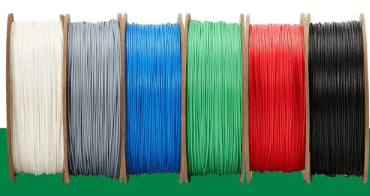There are many different types of filaments available for 3D printing, but some of the most common include:
-
PLA (polylactic acid): This is a biodegradable (under industrial compactor) and from reusable source usually corn. Its easy to print with and produces high-quality prints and stiff. It is available in a wide range of colors and is often used for prototyping and creating models. Although the downside its not temperature resistant, at any elevated temperature materials will creep.
-
ABS (acrylonitrile butadiene styrene): This is a strong, durable, and heat-resistant filament that is often used for creating functional parts and objects. ABS is a bit more challenging to print (Require an enclosure and all metal hotend) with than PLA, but it produces strong and durable parts. ASA is derivative which offer better weatherability and UV rating, making it perfect for outdoor application. Just do note, its will release nasty VOC and filtering is recommended, more information on air filtration.
-
TPU (thermoplastic polyurethane): This is a flexible filament that is often used for creating flexible parts such as phone cases, toys, and other objects that need to bend or flex. Its also quite durable materials that you can print in open printer.
-
PETG (polyethylene terephthalate glycol): This is a strong and durable filament that is similar to ABS, but it is more resistant to impact, chemicals and higher temperatures resistant compare to PLA. It is commonly used for creating functional parts and objects. Although do note, it can creep under constant load so best used as enclosure or where minimal load is required.
-
Nylon: This is a strong and flexible filament (PA6 un-annealed) that is commonly used for creating gears, hinges and other non bearing mechanical parts. It is relative easy to print with and produces high-quality prints. Annealing part is recommend for PA6, while PA12 is less prone to creep and moisture absorption, but annealing is also recommended.

